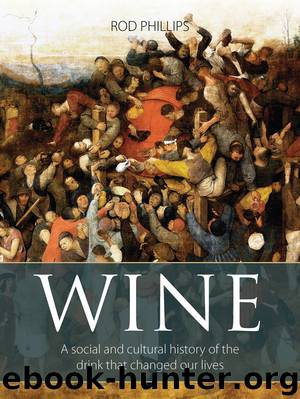Wine by Rod Phillips

Author:Rod Phillips
Language: eng
Format: epub
Publisher: Infinite Ideas
Published: 2018-03-07T16:00:00+00:00
Druitt likens the flavour here to some ingredients common in perfume because of his insistence that Volnay is ‘liquid perfume’. They are not to be thought of as in the wine in any literal sense, but they are a guide to the alliances – the likeness – of the flavour, which is the way in which fruit, berries, and other produce are used as descriptors for wine in modern wine notes. Druitt also occasionally mentions the medicinal properties of specific wines: ‘In neglecting Burgundy wine, we ignore a most powerful remedy for poverty of the blood and an ill-nourished state of the nervous system.’ As for Bordeaux, they ‘like other fine light wines, make pure healthy blood, and at the same time favour the action of the excretory organs; they are good in the anaemia and chlorosis of growing girls’.
Nineteenth-century writing on wine was formal and mannered, but in the first half of the twentieth the approach to wine was dominated by a style that often incorporated literary allusions. The aim was not only to inform readers about wine but to do so in ways that elevated the wine in question. One writer was André Simon, who wrote a hundred books on wine and described a 1926 Chablis as having ‘the grace of a silver willow’. It made the point, even if the reader had never seen a silver willow. The literary style – some might call it flowery – infused advertising, too. A 1955 publication by the English wine agents, Berry Bros & Rudd, read: ‘Claret has well deserved this place in our national life, for it is not only the most perfectly balanced and subtly flavoured of the world’s wines, but also – to quote André Simon – “the most natural and the most wholesome”. If Burgundy is the King of red wines, then Claret is surely the Queen – and many would make her Queen Regnant.’
Fruit descriptors, now the dominant form of describing wines, were rare in this style of wine writing, and the full-fledged use of these and other terms dates back about half a century to the 1960s. One of the early influential exponents of the style was the American wine critic Robert Parker, who also gave the wine world the 100-point scoring system. Using fruit and other terms to describe wine gave emphasis to the aromas and flavour of wine more than ever before. Until that point, description had focused on style, rather than flavour. But while the style of wine could be described in a short note, aromas and flavours presented a broad canvas capable of accommodating a wide spectrum of descriptors drawn from the worlds of fruit, herbs, spices, and other sources of inspiration. Popular terms included ‘barnyard’ and ‘forest floor’, while some writers gave rein to phrases such as ‘a hard-ridden horse’ and ‘sweaty horse’.
In 1990 Ann Noble, a sensory chemist at the University of California at Davis, the premier wine education institution in the United States, devised the Wine Aroma Wheel to give order to the riot of descriptors.
Download
This site does not store any files on its server. We only index and link to content provided by other sites. Please contact the content providers to delete copyright contents if any and email us, we'll remove relevant links or contents immediately.
Whiskies (Collins Gem) by dominic roskrow(42214)
101 Whiskies to Try Before You Die by Ian Buxton(42182)
Whiskies Galore by Ian Buxton(40332)
Craft Beer for the Homebrewer by Michael Agnew(17447)
Right Here, Right Now by Georgia Beers(3497)
Not a Diet Book by James Smith(2726)
Water by Ian Miller(2584)
The Coffee Dictionary by Maxwell Colonna-Dashwood(2531)
Kitchen confidential by Anthony Bourdain(2306)
Coffee for One by KJ Fallon(2008)
Smuggler's Cove: Exotic Cocktails, Rum, and the Cult of Tiki by Martin Cate & Rebecca Cate(1979)
Beer is proof God loves us by Charles W. Bamforth(1920)
Superfood Smoothie Bowls: Delicious, Satisfying, Protein-Packed Blends that Boost Energy and Burn Fat by Chace Daniella(1903)
Talking as Fast as I Can by Lauren Graham(1832)
Bourbon: A Savor the South Cookbook by Kathleen Purvis(1791)
A Short History of Drunkenness by Forsyth Mark(1720)
Eat With Intention by Cassandra Bodzak(1688)
Cocktails for the Holidays by Editors of Imbibe magazine(1626)
Colombia Travel Guide by Lonely Planet(1609)
